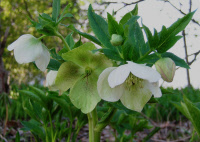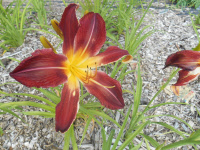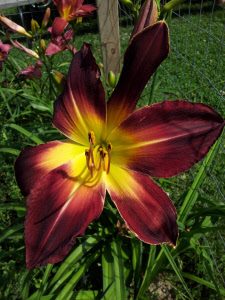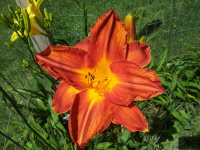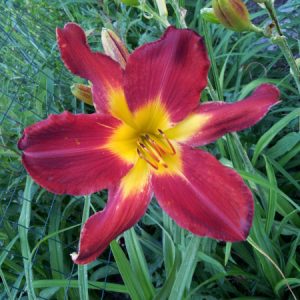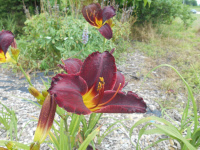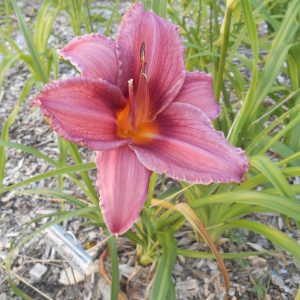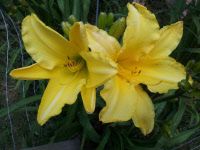Our Plants
Showing 257–264 of 587 results
-
Helleborus orientalis Lenten rose Z 4-9 POISON
Creamy white to pink, waxy saucer-shaped flowers with glowing yellow stamens flowering in early spring with waxy, thick leaves.
Creamy white to pink, waxy saucer-shaped flowers with glowing yellow stamens flowering in early spring with waxy, thick leaves.
Size: 12” x 12”
Care: moist humusy soil in part shade.
Native: Asia Minor
Wildlife Value: its flowers produce large amounts of nectar and pollen feeding many bees, moths, butterflies, and some birds in early spring when few other plants in flower. Deer and rabbit resistant.
Awards: Missouri Botanic Garden Plant of Merit.The name Helleborus is Greek from hellein meaning “to kill” and bora meaning “food” referring to the plant’s poisonous qualities if placed in food. This was identified by Dioscordies in De Materica Medica for medicinal use around 70 A.D. This species found in India in 1839. Favorite plant of Gertrude Jekyll, mother of the mixed perennial border, (1848-1931) planted with Daphne shrubs and Dog tooth violet in her personal garden at Munstead Wood.
-
Hemerocallis ‘Beware of Attack Gardener’ Bob’s daylily Z 4-10
Burgundy petals with golden centers
OUT OF STOCK
Tetraploid daylily with burgundy petals with golden centers. Stripes start golden at center and turn almost white by the point of the petal. Blooms in July.
Robert Koehne (April 1971-September 2014) Bob was a good personal friend and very enthusiastic gardener – perennially cheerful. He loved his wife and two children and daylily breeding. These daylilies are his “children” too. He bred them, named them and registered them. He died of colon cancer too soon – before he could grow grey with Darby or see his kids or his daylilies grow up. We are growing on his daylilies. This year we have only a few to sell but in time these will multiply, hopefully like rabbits. The proceeds go to his family.
Tetraploid daylily with burgundy petals with golden centers. Stripes start golden at center and turn almost white by the point of the petal. Blooms in July.
-
Hemerocallis ‘Black Dirt Live Again’ Bob’s daylily Z 4-10
Flat and open burgundy-purple petals and a yellow center
Tetraploid daylily with flat and open burgundy-purple petals and a yellow center. Blooms in July.
Robert Koehne (April 1971-September 2014) Bob was a good personal friend and very enthusiastic gardener – perennially cheerful. He loved his wife and two children and daylily breeding. These daylilies are his “children” too. He bred them, named them and registered them. He died of colon cancer too soon – before he could grow grey with Darby or see his kids or his daylilies grow up. We are growing on his daylilies. This year we have only a few to sell but in time these will multiply, hopefully like rabbits. The proceeds go to his family.
Tetraploid daylily with flat and open burgundy-purple petals and a yellow center. Blooms in July.
-
Hemerocallis ‘Boozin Susan’ Bob’s daylily Z 4-10
Deep orange petals with a hint of a ruffle and a yellow stripe leading down to a yellow center.
OUT OF STOCK
Tetraploid daylily with deep orange petals with a hint of a ruffle and a yellow stripe leading down to a yellow center. Blooms in July.
Robert Koehne (April 1971-September 2014) Bob was a good personal friend and very enthusiastic gardener – perennially cheerful. He loved his wife and two children and daylily breeding. These daylilies are his “children” too. He bred them, named them and registered them. He died of colon cancer too soon – before he could grow grey with Darby or see his kids or his daylilies grow up. We are growing on his daylilies. This year we have only a few to sell but in time these will multiply, hopefully like rabbits. The proceeds go to his family.
Tetraploid daylily with deep orange petals with a hint of a ruffle and a yellow stripe leading down to a yellow center. Blooms in July.
-
Hemerocallis ‘Florentine Opera’ Bob’s daylily Z 4-10
Tetraploid daylily with flat burgundy petals with a hint of ruffle leading to a yellow center. A yellow stripe makes its way about halfway out each petal. Blooms in July.
Tetraploid daylily with flat burgundy petals with a hint of ruffle leading to a yellow center. A yellow stripe makes its way about halfway out each petal. Blooms in July.
Robert Koehne (April 1971-September 2014) Bob was a good personal friend and very enthusiastic gardener – perennially cheerful. He loved his wife and two children and daylily breeding. These daylilies are his “children” too. He bred them, named them and registered them. He died of colon cancer too soon – before he could grow grey with Darby or see his kids or his daylilies grow up. We are growing on his daylilies. This year we have only a few to sell but in time these will multiply, hopefully like rabbits. The proceeds go to his family.
-
Hemerocallis ‘Franklin Tower’ Bob’s daylily Z 4-10
Slightly ruffled maroon petals with a bright yellow center
Tetraploid daylily with slightly ruffled maroon petals with a bright yellow center.
Robert Koehne (April 1971-September 2014) Bob was a good personal friend and very enthusiastic gardener – perennially cheerful. He loved his wife and two children and daylily breeding. These daylilies are his “children” too. He bred them, named them and registered them. He died of colon cancer too soon – before he could grow grey with Darby or see his kids or his daylilies grow up. We are growing on his daylilies. This year we have only a few to sell but in time these will multiply, hopefully like rabbits. The proceeds go to his family.
Tetraploid daylily with slightly ruffled maroon petals with a bright yellow center.
-
Hemerocallis ‘Gigi Sullivan’ Bob’s daylily Z 4-10
Tetraploid daylily, all mauve-maroon, recurved, centered around a green-gold eye. 23-28” tall, Blossoms 7” across. Blooms in July.
OUT OF STOCK
Tetraploid daylily, all mauve-maroon, recurved, centered around a green-gold eye. 23-28” tall, Blossoms 7” across. Blooms in July.
Robert Koehne (April 1971-September 2014) Bob was a good personal friend and very enthusiastic gardener – perennially cheerful. He loved his wife and two children and daylily breeding. These daylilies are his “children” too. He bred them, named them and registered them. He died of colon cancer too soon – before he could grow grey with Darby or see his kids or his daylilies grow up. We are growing on his daylilies. This year we have only a few to sell but in time these will multiply, hopefully like rabbits. The proceeds go to his family.
-
Hemerocallis ‘Grace Cusick’ Bob’s daylily Z 4-10
Yellow with a light, almost white stripe on each petal and a gentle ruffle on the edge
OUT OF STOCK
Tetraploid daylily, all yellow with a light, almost white stripe on each petal and a gentle ruffle on the edge. Blooms in July.
Robert Koehne (April 1971-September 2014) Bob was a good personal friend and very enthusiastic gardener – perennially cheerful. He loved his wife and two children and daylily breeding. These daylilies are his “children” too. He bred them, named them and registered them. He died of colon cancer too soon – before he could grow grey with Darby or see his kids or his daylilies grow up. We are growing on his daylilies. This year we have only a few to sell but in time these will multiply, hopefully like rabbits. The proceeds go to his family.
Tetraploid daylily, all yellow with a light, almost white stripe on each petal and a gentle ruffle on the edge. Blooms in July.

